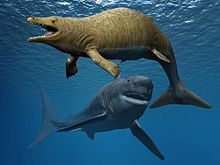| Aegyptocetus Temporal range: Middle Eocene, 41–40 Ma PreꞒ Ꞓ O S D C P T J K Pg N ↓ | |
|---|---|

| |
| Reconstructed skull | |
| Scientific classification | |
| Domain: | Eukaryota |
| Kingdom: | Animalia |
| Phylum: | Chordata |
| Class: | Mammalia |
| Order: | Artiodactyla |
| Infraorder: | Cetacea |
| Family: | †Protocetidae |
| Genus: | †Aegyptocetus Bianucci & Gingerich 2011 |
| Species: | †A. tarfa |
| Binomial name | |
| †Aegyptocetus tarfa Bianucci & Gingerich 2011 | |
Aegyptocetus is an extinct genus of protocetid archaeocete whale known from Egypt.
Taxonomy

Aegyptocetus is known from the articulated holotype MSNTUP I-15459, an almost complete cranium, lower jaws (with teeth) and a partial postcranial skeleton (cervical and thoracic vertebrae and ribs). The specimen was recovered when marbleized limestone was imported commercially to Italy. It was collected in the Khashm el-Raqaba limestone quarry (28°30′N 31°48′E / 28.5°N 31.8°E / 28.5; 31.8, paleocoordinates 22°54′N 27°12′E / 22.9°N 27.2°E / 22.9; 27.2) from the Gebel Hof Formation on the northern flank of Wadi Tarfa in the Eastern Desert of Egypt, dating to the late Mokattamian age of the middle Eocene, about 41 to 40 million years ago. Its cause of death may have been an attack by a large shark as pattern of shark tooth marks preserved on the ribs.
Aegyptocetus was first named by Giovanni Bianucci and Philip D. Gingerich in 2011 and the type species is Aegyptocetus tarfa. The generic name is derived from Aegyptus, Latin for Egypt, and cetus, Latin for whale. The specific name refers to Wadi Tarfa, the desert valley where the holotype was found.
Description

Aegyptocetus had features in its cranium and dentaries adapted for hearing in water. Its thoracic vertebrae (T1–T8), however, had long neural spines which is a characteristic of the weight-bearing system of land-living mammals retained in protocetids, such as Rodhocetus and Qaisracetus, but absent in the more derived basilosaurids, such as Dorudon. This suggests that Aegyptocetus, like other protocetids, was able to support its body on land and probably was semi-aquatic.
References
Notes
- ^ Bianucci & Gingerich 2011
- "Khashm el-Raqaba (Eocene of Egypt)". Paleobiology Database. Retrieved 24 October 2016.
- Bianucci & Gingerich 2011, Adaptations for Moving on Land, p. 1185
Sources
- Bianucci, Giovanni; Gingerich, Philip D. (2011). "Aegyptocetus tarfa, n. gen. et sp. (Mammalia, Cetacea), from the middle Eocene of Egypt: clinorhynchy, olfaction, and hearing in a protocetid whale". Journal of Vertebrate Paleontology. 31 (6): 1173–1188. doi:10.1080/02724634.2011.607985. S2CID 85995809.
| Archaeocete genera by family | |||||||
|---|---|---|---|---|---|---|---|
| |||||||
| Pakicetidae | |||||||
| Ambulocetidae | |||||||
| Remingtonocetidae | |||||||
| Protocetidae |
| ||||||
| Basilosauridae |
| ||||||
| Taxon identifiers | |
|---|---|
| Aegyptocetus | |
| Aegyptocetus tarfa | |